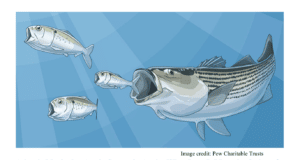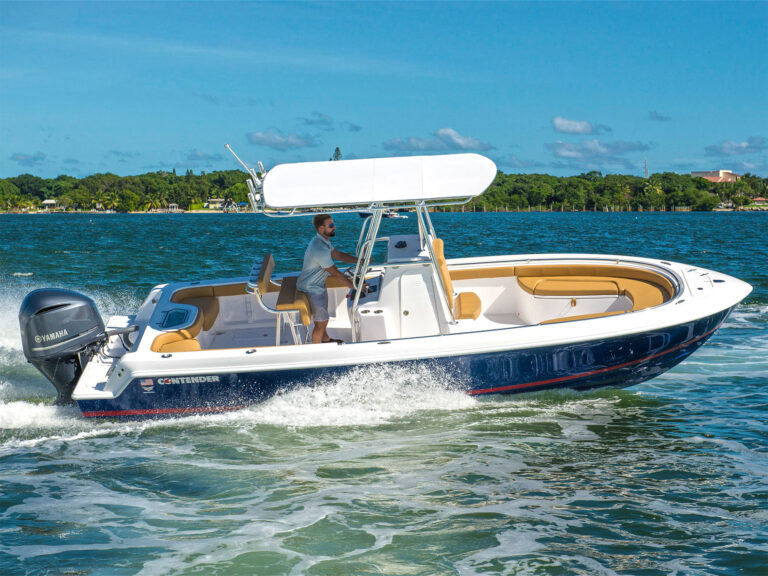Dan is the worst person with whom to go to a boat show. While I’m dreaming and scheming, he’s pointing out what’s hidden under those well-waxed gelcoats. But that’s his job; he’s a certified marine surveyor. To him it’s not about whether the proverbial glass is half full or half empty. He sees that the glass has a tiny blister and may delaminate.
Dan’s so good at what he does that he’s not exactly popular among boatbuilders. He’s faced off with them in courts as an expert witness and come off on top. In fact, Dan isn’t his real name; we’ll just call him that because he’s not all that eager about letting the other side know what he’s doing for us — which is walking me through this boat show and pointing out what builders don’t want us to see.
Good Builders, Bad Boats
“The encouraging thing,” says Dan as we begin our stroll, “is that fiberglass boats have been around for so long that we know how to make good ones.”
“OK, that’s the good news. What’s the bad?” I ask.
“Nothing, really,” says Dan with a wry smile, “if the builder does what it’s supposed to do. But that’s not always the case, or its fault.”
As Dan describes it, the problem is that most boats are not built in numbers that can benefit from high-volume production. For example, if a builder is going to make a lot of one model, it can amortize the cost of a pre-engineered electrical system that is designed to be easily duplicated and capable of being assembled on a bench and then dropped into a boat as one continuous package with a minimum of connections and waste. You get a better product for less money. But if you’re building only a few boats, it doesn’t pay, and the wiring is done piece by piece, lacking uniformity and sometimes quality.
“That’s not to say low-volume production can’t produce great boats,” Dan continues. “The Italian builder Riva takes its time building the magnificent 33-foot Aquariva Super runabout. But prices start at $945,000.” I’m not spending that kind of money, and neither are you, so builders of the boats we buy are forced to compromise.
“So I’m compromising too?” I ask, disheartened.
“Don’t think of it like that,” says Dan, trying to lighten the mood. “These days it’s hard to find what you’d call a ‘bad boat.’ Now it’s just the small stuff we have to look out for. Come on, I’ll show you.”
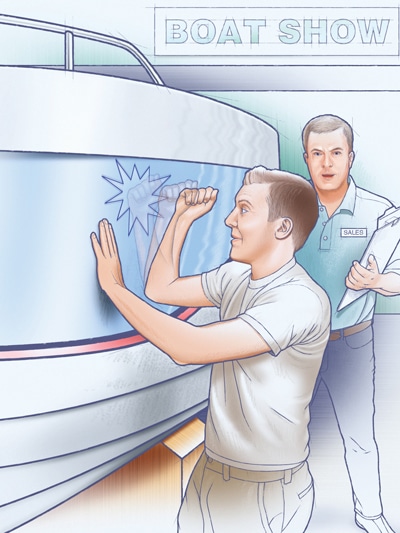
Hull of a Job
Walking along, we stare up at mountains of curvaceous glossy hulls. Dan picks a boat and starts whacking away at it. He puts the palm of one hand on the hull and pounds with his fist about three feet away. “The trend is toward ever-lighter hulls to save money and, if it’s built right, to make the boat more efficient. I didn’t feel any vibrations, so this one’s nice and solid.”
Next, he’s back at the transom sighting forward along the rub rail, explaining that it should appear to be one long, smooth line. Any waves mean that the hull and deck probably didn’t fit well and had to be forced together, creating potential stress points for future leaks.
“This one’s not bad,” says Dan, mumbling happily as he warms to his work, putting his cheek near the hull while bobbing up and down to look for problems in the gelcoat. Shows are a great place to do this because the hull is clean, shined and well-lighted, producing reflections that highlight every defect.
On this boat, there’s a barely perceptible vertical ridge. “Must be where a bulkhead is putting pressure on the hull,” Dan says, predicting a series of hairline cracks in the near future due to this “hard spot,” as such anomalies are called. “Problems like this really stand out on dark hulls, which is one reason white is so popular,” he adds with a conspiratorial grin.
The salesmen are beginning to eye us suspiciously, so I grab Dan and drag him down the aisle to our next victim.
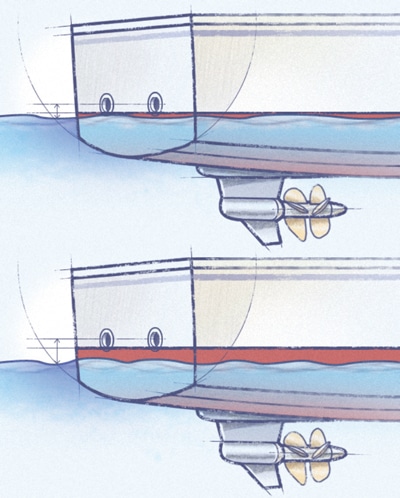
A Draining Experience
We stop at the next booth, and Dan’s already shaking his head. “Look at this cockpit scupper,” he says with disgust. “It’s level with the sole inside and barely an inch above the waterline.” To get a cockpit that’s at least two feet deep (so the gunwale inwale is slightly above your knees), which will keep you from falling overboard without resorting to an ungainly high freeboard, soles are kept low and close to the waterline. Get a heavy rainstorm, back down on a fish or put too much weight aft, and instead of letting water out, that scupper will let it pour in.
“Low scuppers on a truly watertight cockpit aren’t so bad,” lectures Dan with a wagging finger, “but few boats have this.” He points out all the hatches, inspection ports, outboard cable openings, electrical outlets and more — they’re all leak, or down-flooding, points.
Since most cockpits aren’t really watertight, they should drain as rapidly as possible. This fact sets Dan off, as he recites section H-4.6.1.1 of the American Boat and Yacht Council’s formula for “self-bailing cockpits.” I don’t know which is scarier: that Dan has this section memorized or that his figures show that a 24-foot boat should have its sole 5¼ inches above the waterline. The boat we’re looking at doesn’t, and few do.
The reality is that water will eventually get into the bilge and need to be pumped out. but Dan tells me stories of how pump systems can actually let water back in. “builders don’t want the pump to work too hard lifting water out of the bilge or shower sump,” Dan says, “so discharge ports are often installed too low and can let water in. The only protection is to have a riser loop at least 1 foot 6 inches above the waterline.”
So, with flashlight in hand (yes, he carries a flashlight to a boat show), Dan climbs aboard the boat to check the pumps while I assure the salesman that we’re “just looking.”
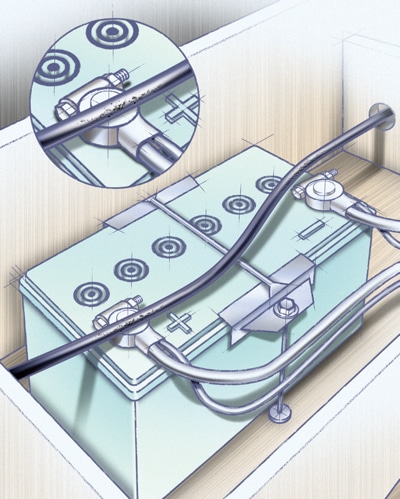
Belly of the Beast
We both squeeze into the engine compartment, and I can immediately see that Dan is not a happy boy. “This is classic,” he says with a sarcastic smile. “Look at the fuel fill.” I do, it looks fine, and I tell him so. “It’s missing a ground wire between the deck fill and the tank to prevent static buildup and a spark when fueling.
“And look over here,” Dan says while shaking his head in disbelief. “The builder tried to save a few bucks by putting rubber boots over the battery terminals rather than completely enclosing the battery in a plastic box.” If the battery top gets wet and dirty, the muck can carry a small current between posts and drain the power. But it could be worse. Some builders put a boot only on the positive post, the minimum requirement of the American Boat and Yacht Council.
Dan now points to fuel lines running above the batteries. “When nonsealed batteries charge, they give off hydrogen,” he says, “which can turn the lines brittle.” So make sure fuel lines, filters and fittings aren’t installed above batteries.
Down here we can also see the dockside water intake, to which Dan gives a thumbs down. “No pressure reducer,” he says. Municipal water can be 60 psi or more, which would blow out the boat’s freshwater system, which is probably only good to 10 psi. “Kind of ironic,” says Dan, “bringing in water to sink your own boat.”
Since we’re both stiff from the cramped compartment, Dan suggests some exercise on the foredeck. “If you want to see if a deck is strong, stand on your toes and bounce up and down. There should be no flex or give.” and there isn’t. We’re about to try the same in the cockpit when the company representative senses that we are not serious buyers — or mentally stable — and directs us to his competitor at the other side of the show.
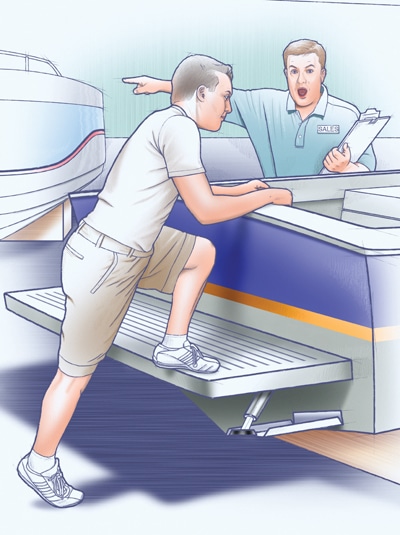
Shocking!
As we walk away, I ask Dan for his opinion on the one greatest trouble spot in boats. His answer is quick and unequivocal: electrical systems. “They’re too easy to get wrong and not always obvious to the installer when they are.” I agree and ask for some examples.
“Pick a boat,” he says. I do, and we climb aboard and snuggle in behind the helm station to check the wiring.
“Here’s a good sign right off,” says Dan with some surprise. “This bus bar has a plastic cover to keep water out even though it’s inside the boat. Not taking chances — I like that.”
I then point out some sloppy workmanship. “Look at all this glop slopped on the connections,” I say, trying to play junior surveyor. “What a mess.”
But Dan crushes my find by telling me that instead of sealing connections with adhesive-lined heat shrink, the rigger used liquid electrical tape — a thick paint that gets into cracks and crevices where regular tape and heat shrink can’t reach. It’s made by Star brite and Plasti Dip and is either an aerosol or a brush-on liquid.
“Everything looks good here, but let’s make one last stop,” says Dan, on the move toward the engine room. Inside, he points to the aluminum AC/DC panel box, also known as the main distribution panel or MDP. “Some builders just scratch-build these out of wood, which makes excellent kindling if things get hot.”
He also makes a point of how neat the wiring is, indicative of care that probably got carried over to other parts of this boat. But all that is soon shot down. “Aw, everything looked so good, too,” whines a disappointed Dan. “See, they’ve run the wires along with the fuel line.” Petroleum products such as diesel, gasoline and even steering fluid should never be bundled with wires. If a wire heats up or sparks and the hose bursts, it’s all over except a call to the insurance company.
It’s Not All That Bad
We climb down from the boat, walk over to the food court and buy the obligatory $6 flabby hot dog and $4 Coke with too much ice.
“I gotta tell ya, Dan, I’m a little depressed.”
“Don’t be. Builders put out the best boats they can, but problems pop up. It’s the nature of how boats are built. That’s why you should always have a pre-purchase survey and learn to accept that no boat is perfect. All new boats are going to need tweaking. Think of it as a bonding experience. Speaking of bonding, make sure to look for a green eight-gauge wire on each…”
“Dan.”
“What?”
“Enough already.” Poor guy can’t help himself, but I’ve got to love him for it — he’s given me quite an education.
The 10-Minute Once Over
Going to a boat show or cruising the dealers? Now is the time to buy. Just make sure you bring along our cheat sheet to see if the boat you’re in love with is a contender or a pretender.
Anchor Locker
It should drain overboard, have a u-bolt to secure the rode’s bitter end and have good access to undo a tangle.
Midship Cleats
They’re often missing but are needed for spring lines. They must be at least one inch long for every one-16th inch of line diameter.
Boarding Ladder
It needs a minimum of three steps with the lowest being three feet or more below the waterline and must be deployable from the water.
Upholstery
Look for piping along the edges and stitches pulled down below fabric level to reduce wear.
Counters
They must have raised lips — fiddles — of at least an inch in height on all sides to keep gear in place.
Hatches
Check to make sure they are at least two feet wide to be useful for entry and exit.
Carpeting
To wear well, it needs to be thick. If it’s hard to fold over on itself or to crease, it’s oK.
Screens
Many builders save a few bucks by not including screens for ports and hatches.
Windshield Frames
Look for at least two support posts. Give the frame a few good yanks to see if all is secure.
Bunks
Padding must be at least four inches thick; five to seven inches is better. After you get up, the indent should immediately disappear.

Flex test
There’s only so much you can learn from looking at a boat on land; while it’s always possible to get a feel for flex in the sole by jumping up and down, the next step is to get it on the water. To begin with, stop looking and start listening.
Go out in a two-foot chop. Let the boat pound. It should sound solid, with no creaking or groaning. If it doesn’t, things are flexing and moving when they shouldn’t. When it’s calm, produce waves by running over your wake. Also, try a few high-speed turns. The best place to listen is up and forward; it’s a high-stress area and gets you away from the noise of the engines. Put your ear to a bow rail; it’s a good sound amplifier.
See if doors and drawers open and close as they did at the dock. If not, the hull/deck structure is twisting. Put a piece of cardboard in a gap between a door and frame. If it wiggles or falls out, that component is working along with the hull, which could be a problem.
On boats with wide-open spaces, such as motoryachts, tightly tie a string athwartships across the space. See if it sags and tightens while under way.
Certified Marine Surveyors
SAMS–Society of Accredited Marine Surveyors:
National Assoc, of Marine Surveyors:
CMS–Certified Marine Surveyors:

